AREA OF PARALLELOGRAM WORKSHEET
Problem 1 :
Find the area of the parallelogram ABCD shown below.
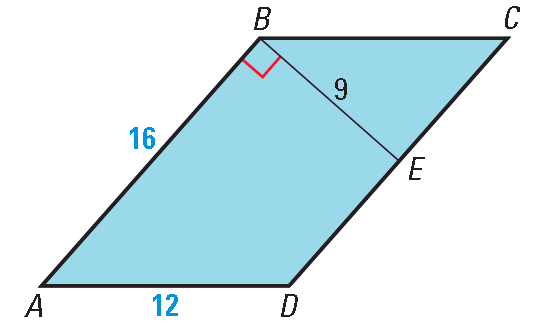
Problem 2 :
Find the area of the parallelogram ABCD shown below.
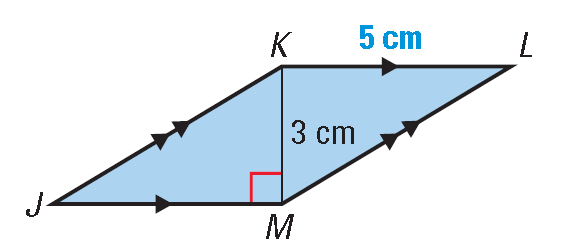
Problem 3 :
A mirror is made of two congruent parallelograms as shown in the diagram. The parallelograms have a combined area of 9 1/3 square yards. The height of each parallelogram is 1 1/3 yards. How long is the base of each parallelogram ?
Solution :
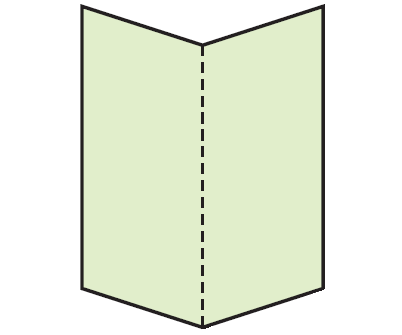
Problem 4 :
Find the base of a parallelogram if its area is 40 square cm and its altitude is 15 cm.
Problem 5 :
Find the area of the shape shown below.
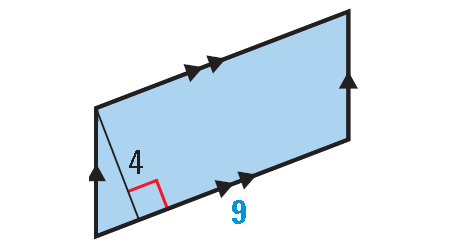
Problem 6 :
If the area of the shape shown below is 60 square inches, then find the value of x.
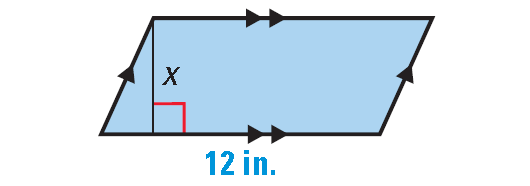

Detailed Answer Key
Problem 1 :
Find the area of the parallelogram ABCD shown below.

Solution :
Method 1 :
Use AB as the base.
So, b = 16 and h = 9.
Formula for area of a parallelogram is
= b ⋅ h
Substitute the given measures.
= 16 ⋅ 9
= 144 square units
Method 2 :
Use AD as the base.
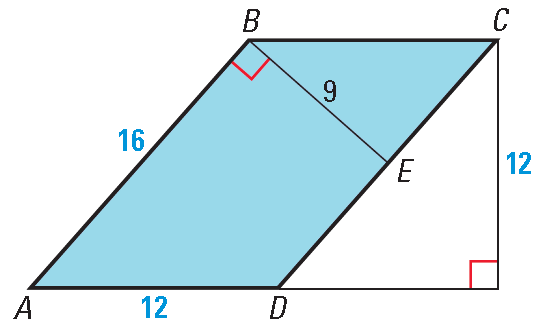
So, b = 12 and h = 12.
Formula for area of a parallelogram is
= b ⋅ h
Substitute the given measures.
= 12 ⋅ 12
= 144 square units
Problem 2 :
Find the area of the parallelogram ABCD shown below.

Formula for area of a parallelogram is
= b ⋅ h
Substitute b = 5 and h = 3.
= 5 ⋅ 3
= 15 square units
Problem 3 :
A mirror is made of two congruent parallelograms as shown in the diagram. The parallelograms have a combined area of 9 1/3 square yards. The height of each parallelogram is 1 1/3 yards. How long is the base of each parallelogram ?
Solution :

Because the given parallelograms are congruent area of two parallelogram will be equal.
Combined area of parallelograms = 9 1/3 square yards
Combined area of parallelograms = 28/3 square yards
Area of one parallelogram = (28/3) ÷ 2
Area of one parallelogram = 14/3
b ⋅ h = 14/3
b ⋅ 1 1/3 = 14/3
b ⋅ 4/3 = 14/3
Multiply each side by 3/4.
b = 14/3 ⋅ 3/4
b = 14/4
b = 7/2
b = 3 1/2
So, the base of the parallelogram is 3 1/2 yards.
Problem 4 :
Find the base of a parallelogram if its area is 40 square cm and its altitude is 15 cm.
Solution :
Area of a parallelogram = 40 cm2
b ⋅ h = 40
Here, altitude (or) height (h) = 15 cm.
b ⋅ 15 = 40
Divide each side by 15.
b = 2.67
So, the base of the parallelogram is 2.67 inches.
Problem 5 :
Find the area of the shape shown below.

The above shape has four sides. So, it is a quadrilateral. Because the opposite sides are parallel, the above quadrilateral is a parallelogram.
Formula for area of a parallelogram is
= b ⋅ h
Substitute b = 9 and h = 4.
= 9 ⋅ 4
= 36 square units
Problem 6 :
If the area of the shape shown below is 60 square inches, then find the value of x.

Solution :
Given : Area of the above shape is 60 square inches.
The above shape has four sides. So, it is a quadrilateral. Because the opposite sides are parallel, the above quadrilateral is a parallelogram.
Area = 60 in2
b ⋅ h = 60
Substitute b = 12 and h = x.
12 ⋅ x = 60
Divide each side by 12.
x = 5
Kindly mail your feedback to v4formath@gmail.com
We always appreciate your feedback.
©All rights reserved. onlinemath4all.com
Recent Articles
-
10 Hard SAT Math Questions (Part - 11)
Sep 11, 25 08:23 AM
10 Hard SAT Math Questions (Part - 11) -
Digital SAT Math Problems and Solutions (Part - 256)
Sep 10, 25 07:02 PM
Digital SAT Math Problems and Solutions (Part - 256) -
10 Hard SAT Math Questions (Part - 10)
Sep 10, 25 06:56 PM
10 Hard SAT Math Questions (Part - 10)
